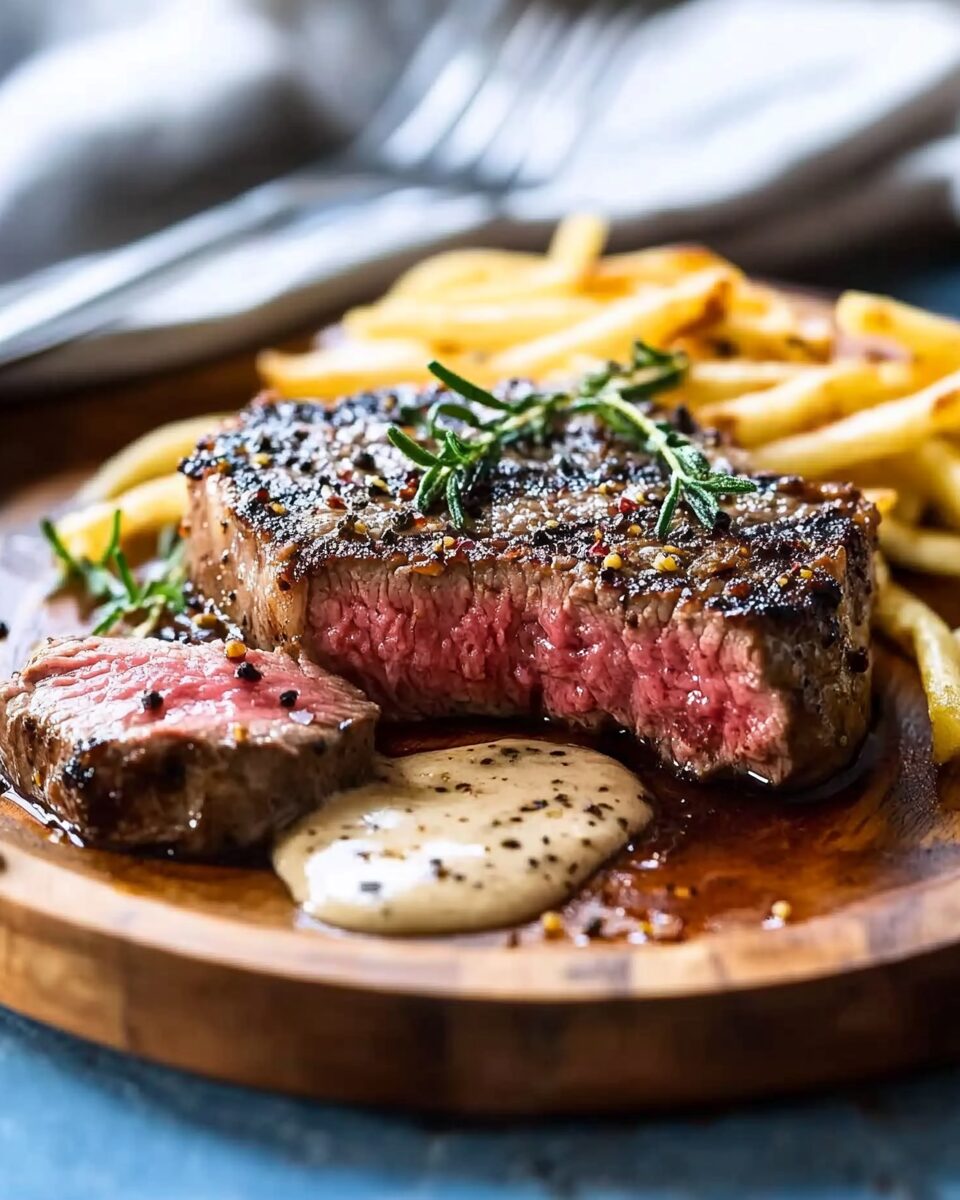Steak au Poivre combines the bold spiciness of cracked peppercorns with the smooth elegance of a creamy pan sauce. Each bite is an indulgent harmony of textures and flavors, making this dish a star in French cuisine.
This recipe is surprisingly approachable for home cooks and yields restaurant-quality results. The peppercorn crust brings a smoky depth, while the sauce adds a luxurious, tangy richness. Perfect for a romantic dinner or an elevated weeknight treat.
Full Recipe:
- 4 (6- to 8-ounce; 170 to 225g) boneless medallion steaks, such as filet mignon
- Kosher salt
- 1 ounce (30g) whole black peppercorns, divided
- 3 tablespoons (45ml) vegetable oil
- 1 tablespoon (15g) unsalted butter
- 2 thyme sprigs
- 1 garlic clove
- 1/2 large shallot (about 1 1/2 ounces; 40g), minced
- 2 tablespoons (30ml) brandy or cognac
- 3/4 cup (175ml) chicken stock (homemade or low-sodium store-bought)
- 3/4 cup (175ml) heavy cream or 6 tablespoons (90ml) crème fraîche
- 1 teaspoon (5ml) Dijon mustard
Directions:
- Season steaks with kosher salt and air-dry on a rack in the fridge for 30 minutes.
- Crack peppercorns coarsely with a mortar and pestle or rolling pin. Press steaks into cracked peppercorns on one side only.
- Preheat oven to 375°F (190°C).
- Heat oil in a skillet over medium-high heat. Sear steaks, peppered side down, for 3 minutes. Flip and add butter, thyme, and garlic. Baste steaks until seared.
- Transfer steaks to a baking sheet and finish cooking in the oven until internal temperature reaches 125°F (52°C) for medium-rare. Rest steaks for 5 minutes.
- Remove excess fat from the skillet. Sauté shallots and remaining peppercorns until tender.
- Deglaze with brandy, simmering to reduce. Add chicken stock and reduce further.
- Stir in cream or crème fraîche, whisk in Dijon mustard, and simmer until the sauce thickens.
- Serve steaks topped with the sauce.
Prep Time: 40 minutes | Cooking Time: 20 minutes | Total Time: 1 hour
Kcal: 550 kcal | Servings: 4 servings
Steak au Poivre: A Timeless French Culinary Classic
Steak au Poivre, a dish deeply rooted in French gastronomy, embodies the elegance and simplicity that defines French cooking. Translating to “pepper steak,” this recipe is renowned for its robust flavors, tender texture, and a creamy pan sauce that elevates it into a gourmet delight. The dish has captivated food lovers around the world, becoming a mainstay in both upscale restaurants and home kitchens alike.
At its core, Steak au Poivre celebrates the art of balance: the earthy, spicy heat of cracked peppercorns paired with the luxurious creaminess of a velvety sauce. Yet, despite its sophisticated reputation, the dish is remarkably straightforward to prepare, making it an inviting choice for novice and experienced cooks alike.
The History of Steak au Poivre
The origins of Steak au Poivre can be traced to France, where pepper was historically a highly prized spice. In the 19th century, as French cuisine developed its reputation for refinement and innovation, dishes like Steak au Poivre showcased the skill of balancing bold and subtle flavors. The use of cracked peppercorns as a crust for steak highlighted their ability to enhance rather than overpower the natural flavors of high-quality beef.
Peppercorns were once considered a luxury item, often traded like gold. Their inclusion in dishes such as Steak au Poivre symbolized opulence and sophistication. This historical association with luxury persists today, lending the dish its enduring appeal.
What Makes Steak au Poivre Special?
Steak au Poivre stands out not only for its bold flavor profile but also for its versatility and universal appeal. The key lies in its preparation and ingredients. The choice of steak—usually filet mignon or other tender cuts—ensures a melt-in-your-mouth texture. The cracked peppercorn crust provides a satisfying crunch and a hint of heat that contrasts beautifully with the silky sauce.
The sauce itself is a masterpiece of French culinary techniques. Made by deglazing the pan with brandy or cognac and reducing it with cream or crème fraîche, the sauce absorbs the caramelized flavors left behind by the seared steak. A hint of Dijon mustard adds depth, while the subtle tang of crème fraîche (if used) provides a delightful complexity. This combination creates a harmonious blend of flavors, elevating the dish into a true culinary experience.
A Dish Perfect for Every Occasion
One of the many charms of Steak au Poivre is its adaptability. It can be a centerpiece for a formal dinner party or a comforting meal for a quiet evening at home. Paired with sides like creamy mashed potatoes, crispy French fries, or sautéed vegetables, it offers endless possibilities for customization.
For wine enthusiasts, the dish pairs beautifully with a bold red wine like a Bordeaux or Cabernet Sauvignon. The richness of the steak and sauce complements the tannins and complexity of the wine, creating a dining experience that is as indulgent as it is satisfying.
Tips for Success
Though the recipe is simple, there are a few techniques that ensure Steak au Poivre reaches its full potential. First, the steak should be seasoned and allowed to dry-brine in the refrigerator for at least 30 minutes. This step not only enhances the flavor but also helps the cracked peppercorns adhere better to the meat.
When cracking the peppercorns, achieving the right texture is essential. They should be coarsely ground into halves or quarters, which allows them to toast properly during cooking. Too fine, and they risk burning; too large, and they can overwhelm the dish with uneven bursts of heat.
The cooking process itself is also key. Searing the peppered side of the steak first ensures the crust develops a deep, toasted flavor. Meanwhile, leaving one side of the steak bare allows for a proper sear on the meat, building the fond (the browned bits in the pan) that is crucial for a rich, flavorful sauce.
Finally, the sauce should be reduced to a consistency that lightly coats the back of a spoon. Over-reducing can make the sauce too thick, while under-reducing will result in a watery texture that fails to cling to the steak.
Why You Should Make Steak au Poivre at Home
While Steak au Poivre may seem like a dish best left to the professionals, it is surprisingly accessible for home cooks. The preparation requires only basic kitchen tools—a skillet, a pepper mill or mortar and pestle, and a good instant-read thermometer. With these essentials and some attention to detail, anyone can achieve restaurant-quality results.
Cooking Steak au Poivre at home also allows for personalization. You can adjust the level of pepperiness, choose your preferred cut of steak, or experiment with the sauce by adding fresh herbs or substituting chicken stock for beef stock. This flexibility ensures the dish can be tailored to your tastes and dietary preferences.
Cultural Significance and Modern Interpretations
In many ways, Steak au Poivre represents the quintessential French approach to cooking: honoring high-quality ingredients and employing time-tested techniques to create a dish that is greater than the sum of its parts. Its enduring popularity speaks to its universal appeal and timeless charm.
In modern cuisine, variations on Steak au Poivre have emerged, from vegetarian versions using cauliflower or portobello mushrooms to fusion interpretations incorporating Asian spices. These adaptations highlight the versatility of the dish and its ability to inspire creativity in the kitchen.
Conclusion
Steak au Poivre is more than just a recipe—it is an experience that brings together the warmth of home cooking with the sophistication of French gastronomy. Its bold flavors, rich history, and approachable preparation make it a dish worth mastering. Whether you’re preparing it for a special occasion or a simple dinner, Steak au Poivre is guaranteed to impress and delight.
As you savor each bite, you’ll appreciate not only the dish itself but also the culinary traditions and artistry it represents. So gather your ingredients, heat up your skillet, and let Steak au Poivre transport you to the heart of France with every forkful.






